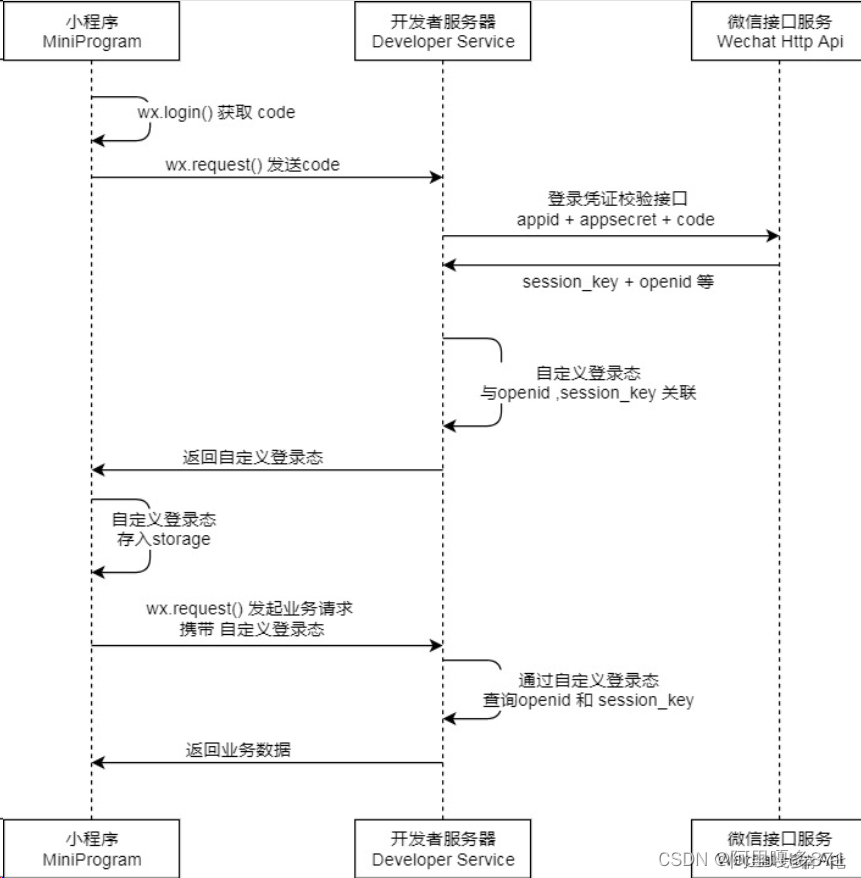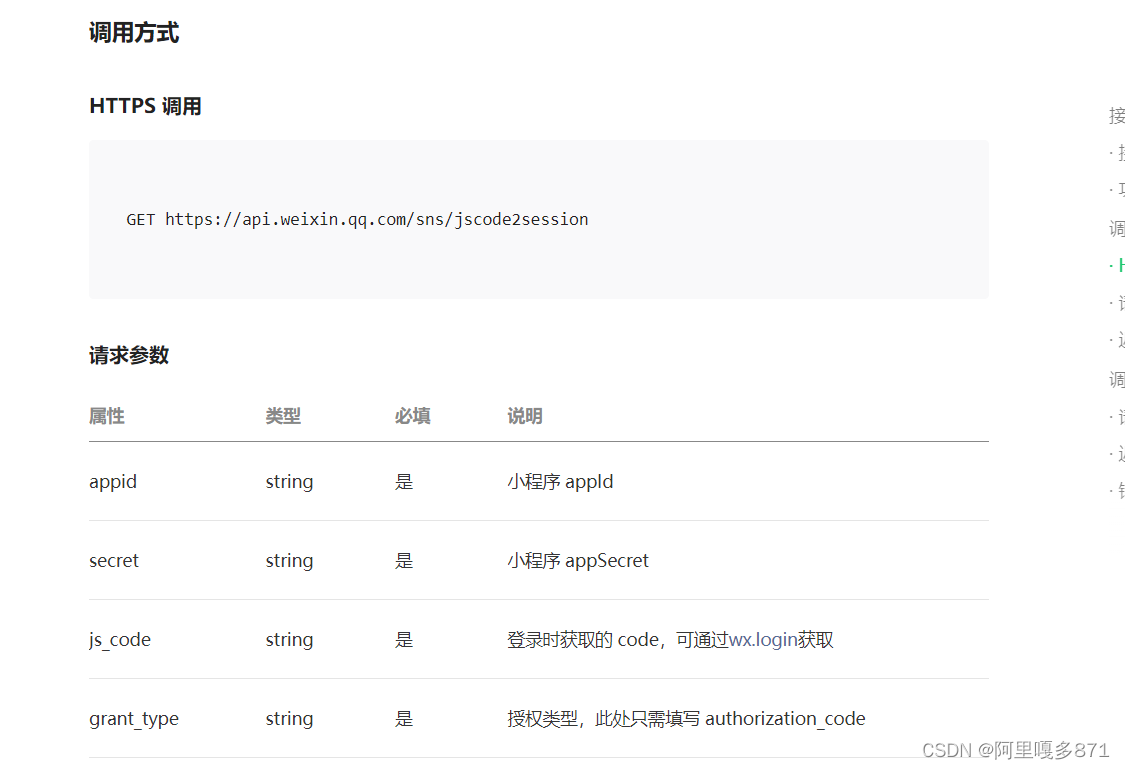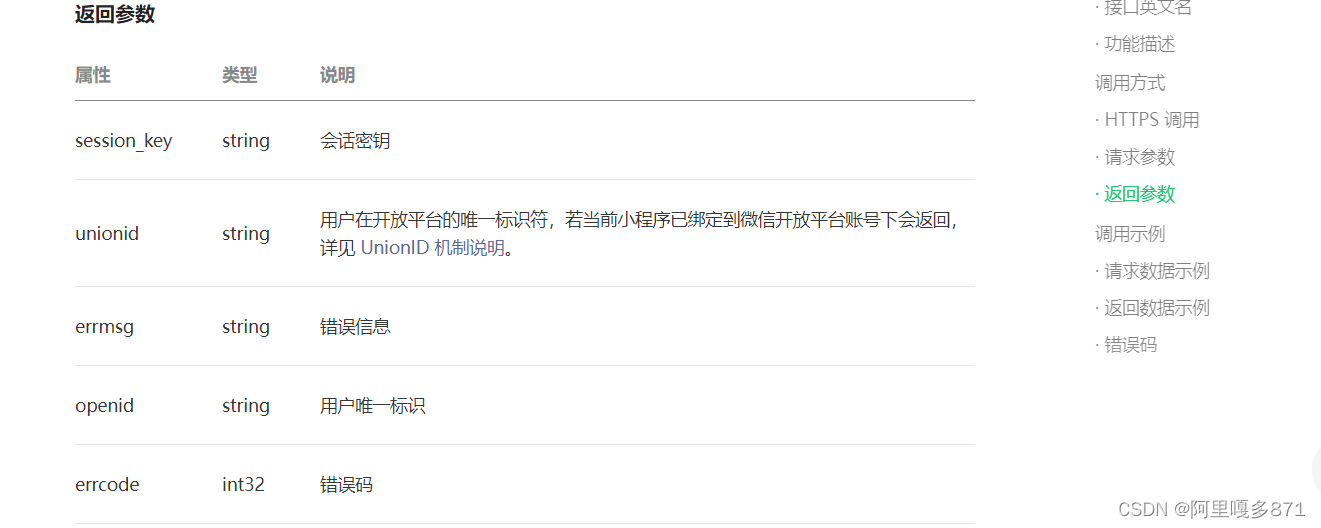一、
微信登录的流程:

1.首先登录界面点击登录获取一个登录编号code(每次点击不一样),然后发送到后端,再由后端发送appid+app密钥和code调用微信的接口服务(通过HttpClient发送请求)。
2.获取唯一微信登录标识openid,查询数据库有没有该用户,没有则添加。
3.使用jwt工具类生成token,返回token,用户id和openid;


二、
项目中实现
1.定义一个properties类,springbootDI注入
@Component
@ConfigurationProperties(prefix = "sky.wechat")
@Data
public class WeChatProperties {
private String appid; //小程序的appid
private String secret; //小程序的秘钥
private String mchid; //商户号
private String mchSerialNo; //商户API证书的证书序列号
private String privateKeyFilePath; //商户私钥文件
private String apiV3Key; //证书解密的密钥
private String weChatPayCertFilePath; //平台证书
private String notifyUrl; //支付成功的回调地址
private String refundNotifyUrl; //退款成功的回调地址
}2.在yml或者properties文件中注入相关数据
wechat:
appid: 你注册的appid
secret: 你的密钥3.导入工具类
public class HttpClientUtil {
static final int TIMEOUT_MSEC = 5 * 1000;
/**
* 发送GET方式请求
* @param url
* @param paramMap
* @return
*/
public static String doGet(String url,Map<String,String> paramMap){
// 创建Httpclient对象
CloseableHttpClient httpClient = HttpClients.createDefault();
String result = "";
CloseableHttpResponse response = null;
try{
URIBuilder builder = new URIBuilder(url);
if(paramMap != null){
for (String key : paramMap.keySet()) {
builder.addParameter(key,paramMap.get(key));
}
}
URI uri = builder.build();
//创建GET请求
HttpGet httpGet = new HttpGet(uri);
//发送请求
response = httpClient.execute(httpGet);
//判断响应状态
if(response.getStatusLine().getStatusCode() == 200){
result = EntityUtils.toString(response.getEntity(),"UTF-8");
}
}catch (Exception e){
e.printStackTrace();
}finally {
try {
response.close();
httpClient.close();
} catch (IOException e) {
e.printStackTrace();
}
}
return result;
}
/**
* 发送POST方式请求
* @param url
* @param paramMap
* @return
* @throws IOException
*/
public static String doPost(String url, Map<String, String> paramMap) throws IOException {
// 创建Httpclient对象
CloseableHttpClient httpClient = HttpClients.createDefault();
CloseableHttpResponse response = null;
String resultString = "";
try {
// 创建Http Post请求
HttpPost httpPost = new HttpPost(url);
// 创建参数列表
if (paramMap != null) {
List<NameValuePair> paramList = new ArrayList();
for (Map.Entry<String, String> param : paramMap.entrySet()) {
paramList.add(new BasicNameValuePair(param.getKey(), param.getValue()));
}
// 模拟表单
UrlEncodedFormEntity entity = new UrlEncodedFormEntity(paramList);
httpPost.setEntity(entity);
}
httpPost.setConfig(builderRequestConfig());
// 执行http请求
response = httpClient.execute(httpPost);
resultString = EntityUtils.toString(response.getEntity(), "UTF-8");
} catch (Exception e) {
throw e;
} finally {
try {
response.close();
} catch (IOException e) {
e.printStackTrace();
}
}
return resultString;
}
/**
* 发送POST方式请求
* @param url
* @param paramMap
* @return
* @throws IOException
*/
public static String doPost4Json(String url, Map<String, String> paramMap) throws IOException {
// 创建Httpclient对象
CloseableHttpClient httpClient = HttpClients.createDefault();
CloseableHttpResponse response = null;
String resultString = "";
try {
// 创建Http Post请求
HttpPost httpPost = new HttpPost(url);
if (paramMap != null) {
//构造json格式数据
JSONObject jsonObject = new JSONObject();
for (Map.Entry<String, String> param : paramMap.entrySet()) {
jsonObject.put(param.getKey(),param.getValue());
}
StringEntity entity = new StringEntity(jsonObject.toString(),"utf-8");
//设置请求编码
entity.setContentEncoding("utf-8");
//设置数据类型
entity.setContentType("application/json");
httpPost.setEntity(entity);
}
httpPost.setConfig(builderRequestConfig());
// 执行http请求
response = httpClient.execute(httpPost);
resultString = EntityUtils.toString(response.getEntity(), "UTF-8");
} catch (Exception e) {
throw e;
} finally {
try {
response.close();
} catch (IOException e) {
e.printStackTrace();
}
}
return resultString;
}
private static RequestConfig builderRequestConfig() {
return RequestConfig.custom()
.setConnectTimeout(TIMEOUT_MSEC)
.setConnectionRequestTimeout(TIMEOUT_MSEC)
.setSocketTimeout(TIMEOUT_MSEC).build();
}
}4.表现层接口
@RestController
@RequestMapping("/user/user")
public class UserController {
@Autowired
private UserService userService;
@Autowired
private JwtProperties jwtProperties;
@PostMapping("/login")
public Result<UserLoginVO> login(@RequestBody UserLoginDTO userLoginDTO){
//调用业务层login方法(核心)
User user=userService.login(userLoginDTO);
//生成token,有很多种方式,挑一个顺手的
Map<String, Object> claims = new HashMap<>();
claims.put(JwtClaimsConstant.USER_ID, user.getId());
String token = JwtUtil.createJWT(jwtProperties.getUserSecretKey(), jwtProperties.getUserTtl(), claims);
UserLoginVO userLoginVO=new UserLoginVO();
userLoginVO.setId(user.getId());
userLoginVO.setOpenid(user.getOpenid());
userLoginVO.setToken(token);
//返回数据,里面封装了用户的id和最重要的用户的openid(相当于微信的令牌)和本业务令牌token
return Result.success(userLoginVO);
}
}5.业务层登录处理
@Service
@Transactional
public class UserServiceImpl extends ServiceImpl<UserMapper, User> implements UserService {
private static final String URL = "https://api.weixin.qq.com/sns/jscode2session";
@Autowired
private WeChatProperties weChatProperties;
@Autowired
private UserMapper userMapper;
@Override
public User login(UserLoginDTO userLoginDTO) {
//调用接口微信需要接口路径,开发者的appid,密钥和登录code
//先用map封装开发者的appid,密钥和登录code
Map<String,String> map=new HashMap<>();
map.put("appid",weChatProperties.getAppid());
map.put("secret",weChatProperties.getSecret());
map.put("js_code",userLoginDTO.getCode());
map.put("grant_type","authorization_code");
//向接口发送请求,返回json串数据
String json=HttpClientUtil.doGet(URL,map);
JSONObject jsonObject = JSON.parseObject(json);
String openid = jsonObject.getString("openid");
//如果openid==0说明你三个数据有错误,抛出自定义异常
if (openid == null) {
throw new LoginFailedException(MessageConstant.LOGIN_FAILED);
}
//查看是否存储该用户
User user = userMapper.selectOne(new LambdaQueryWrapper<User>().eq(User::getOpenid, openid));
//没有插入
if (user == null) {
user=new User();
user.setOpenid(openid);
user.setCreateTime(LocalDateTime.now());
userMapper.insert(user);
}
return user;
}
}





















 581
581











 被折叠的 条评论
为什么被折叠?
被折叠的 条评论
为什么被折叠?








